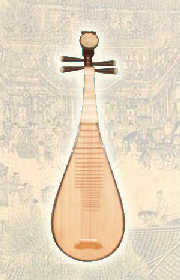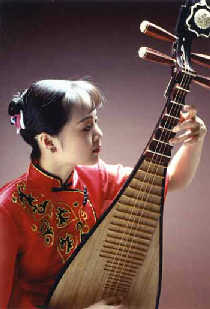| Art Q&A > Music |
|
|
Pipa (Lute)
From the Tang and Song dynasties, the pipa underwent unceasing development, until it attained the form it has today: a semi-pear-shaped sound box, paulownia-wood top board, the neck curved backwards, "xiang" and "pin" frets on the body and neck, four strings and four- or five-octave intervals. Two major changes which took place in the course of the pipa's evolution were the practice of holding the instrument upright instead of horizontally while playing it, and the use of five fingers to pluck the strings, instead of using a plectrum. In the 20th century, through the unremitting efforts of a large number of performing artists and composers, a plethora of techniques and compositions has emerged, with the result that the pipa is now one of China's most important national instruments for solo, accompaniment and ensemble recital. Leading modern pipa artists are Li Tingsong, Wei Zhongyue, Liu Dehai and Lin Shicheng. The long-time history endowed pipa a rich collection of scores and a mature performing technique. Some of the most noteworthy pipa works are: Surrounded on All Sides, also known as The State of Han Conquers the State of Chu . The score first appeared in a collection of Pipa Scores of 1819. The Sunny Hall Collection of the Ming Dynasty contains a graphic account of the pipa master Yang Yingceng performing this piece, which belongs to the genre known as "martial suites". Its background is the struggle between Liu Bang, king of the State of Han, and Xiang Yu, king of the State of Chu, and specifically the final battle between them at Gaixia in 202. The work lauds the victor, Liu Bang. Surrounded on All Sides gives full play to all the pipa techniques - rubbing, plucking, pushing, sweeping, etc., and the music is imbued with the stirring flavor of battle and heroism. Its narrative structure is divided into three parts: (1) Battle preparations, which is again divided into setting up camp, striking up the band, mustering the officers, forming ranks and marching off; (2) The battlefield, which is again divided into the ambush, the engagement at Cockcrow Hill and the battle of Mount Jiuli; and (3 the conclusion, which is divided into the defeat of Xiang Yu's army, suicide by the River Wu, the victory celebrations, the exploits of the generals, and the returning to camp in triumph. The Overlord Doffs His Armor also describes the battle of Gaixia, but while Surrounded on All Sides is a paean of praise to the victorious Liu Bang, The Overlord Doffs His Armor stresses the agony of the defeat suffered by Xiang Yu, king of Western Chu. Hence, the popular saying: The successful play Surrounded on All Sides , while the unsuccessful play The Overlord Doffs His Armor . With the message that heroism cannot be judged on the basis of success or failure, the latter piece of music uses mournful measures to portray the distress of Xiang Yu, the greatest hero of his time. These two complementary works are representative of the "martial suite" pipa genre. The score of The Sunny Spring Classic, or Sunny
Spring Snow , first appeared in the New Scores of 13 Daqu Pipa Suites
of The score of Flutes and Drums at Sunset, first appeared in a manuscript by Wu Wanqing in 1875. It is included in the New Scores of 13 Daqu Pipa Suites of the Northern and Southern Schools . The structure includes a lengthy 10 parts. It is an elegant and charmingly lyrical piece of music. The first section is an introduction, which describes boats bobbing on the river at sunset while flutes and drums play in harmony. The gentle plucking of the pipa's strings is made to sound like the tapping of drums, while twanging them gives the impression of undulating flute notes. The whole presents an enchanting picture of a tranquil autumn evening by a river with boats, and the moon starting to rise. |
||
All rights reserved. Reproduction of text for non-commercial purposes is permitted provided that both the source and author are acknowledged and a notifying email is sent to us. |
||
 |

